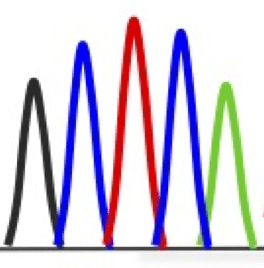Lissencephaly and cerebellar hypoplasia, RELN-related
Gene: RELN
Transmission: Autosomal, recessive (probable)
For an autosomal recessive genetic disease an animal must have two copies of the mutation in question to be at risk of developing the disease. Both parents of an affected animal must be carriers of at least one copy of the mutation. Animals that have only one copy of the mutation are not at risk of developing the disease but are carrier animals that can pass the mutation on to future generations.
Mutation: Deletion, RELN gene: c.2839delG, p.(Val947 STOP), chromosome 18.
Breed: White Swiss Shepherd Dog
Medical system: Neurological
Age of onset of symptoms: By 2 weeks.
Cerebellar hypoplasia is a neurological condition in which the cerebellum is smaller and less well developed than normal, due to genetic lesions or environmental factors. Lissencephaly refers to a “smooth brain”, whereby the brain lacks normal folds (sulci) and grooves (gyri). Two puppies from a New Zealand pedigree of White Swiss Shepherds were seen to have progressive ataxia and difficulties in standing and walking by two weeks of age. Autopsy examination revealed cerebellar hypoplasia as well as lissencephaly and hydrocephaly. Disorganized cerebellar cell layers were demonstrated on histological examination. DNA studies of the pedigree revealed a homozygous mutation in the RELN gene as the cause of the neurological phenotype. The RELN gene codes for the Reelin protein which is an extracellular matrix glycoprotein involved in nerve cell migration during brain development. Mutations in the RELN gene are known to cause cerebellar hypoplasia phenotypes in humans. Furthermore, the Reelin protein is also known to interact with the VLDLR gene product, the mutation of which is responsible for cerebellar hypoplasia in Eurasier dog breed.
The DNA studies performed on the affected pedigree were useful in identifying and confirming the genetic cause of the cerebellar hypoplasia phenotype. Analysis of 88 White Swiss Shepherds of European origin did not detect the mutation, while analysis of 722 additional genomes from other breeds again did not detect the mutation. Veterinarians and breeders should be aware of these findings, and further DNA studies of the White Swiss Shepherd breed will be informative.
See also:
VLDLR gene, Eurasier. OMIA link [1947-9615]
References:
OMIA link: [1867-9615]
Cocostîrc V, Paștiu AI, Pusta DL. (2023) An overview of canine inherited neurological disorders with known causal variants. Animals (Basel) 13:3568. [pm/38003185]
Littlejohn MD, Sneddon N, Dittmer K, et al. (2023) A frameshift-deletion mutation in Reelin causes cerebellar hypoplasia in White Swiss Shepherd dogs. Anim Genet 54:632-636. [pm/37334487]
Contributed by: Lucas Bernard and Marc-Aurèle Burgess, Class of 2029, Faculté de médecine vétérinaire, Université de Montréal. (Translation DWS)

